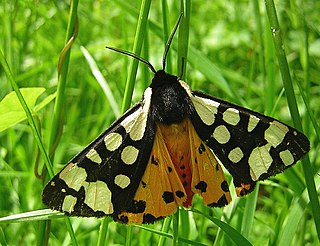
Lepidoptera or lepidopterans is an order of winged insects which includes butterflies and moths. About 180,000 species of the Lepidoptera have been described, representing 10% of the total described species of living organisms, making it the second largest insect order with 126 families and 46 superfamilies, and one of the most widespread and widely recognizable insect orders in the world.

The Arctiinae are a large and diverse subfamily of moths with around 11,000 species found all over the world, including 6,000 neotropical species. This subfamily includes the groups commonly known as tiger moths, which usually have bright colours, footmen, which are usually much drabber, lichen moths, and wasp moths. Many species have "hairy" caterpillars that are popularly known as woolly bears or woolly worms. The scientific name Arctiinae refers to this hairiness. Some species within the Arctiinae have the word "tussock"' in their common names because they have been misidentified as members of the Lymantriinae subfamily based on the characteristics of the larvae.
Sir George Francis Hampson, 10th Baronet was an English entomologist.

The Arctiina are a subtribe of moths in the family Erebidae.
Hypomolis is a genus of moths in the subfamily Arctiinae erected by George Hampson in 1901.
The Global Lepidoptera Names Index (LepIndex) is a searchable database maintained by the Department of Entomology at the Natural History Museum, London. It is based on card indices and scanned journals, nomenclatural catalogues and the Zoological Record. It contains most of world's Lepidoptera names published until 1981 and for some groups is up to date. As of May 2023, the site reads "Database last updated January 2018" so the current validity of the taxonomic combinations presented should be adopted with caution.

Hypomolis aeruginosa is a moth of the family Erebidae. It was described by Felder and Rogenhofer in 1874. It is found in Colombia and Peru.
Hypomolis agnes is a moth of the family Erebidae. It was described by Hervé de Toulgoët in 1982. It is found in Peru.
Hypomolis evippus is a moth of the family Erebidae. It was described by Herbert Druce in 1898. It is found in Bolivia.
Hypomolis lachaumei is a moth of the family Erebidae. It was described by Hervé de Toulgoët in 1982. It is found in Bolivia.
Hypomolis lymphasea is a moth of the family Erebidae. It was described by Paul Dognin in 1892. It is found in Ecuador.
Hypomolis ockendeni is a moth of the family Erebidae. It was described by Walter Rothschild in 1910. It is found in Peru.
Hypomolis roseicincta is a moth of the family Erebidae. It was described by Paul Dognin in 1913. It is found in Colombia.
Hypomolis sanguinipectus is a moth of the family Erebidae. It was described by Adalbert Seitz in 1919. It is found in Colombia and Peru.
Hypomolis thiaucourti is a moth of the family Erebidae. It was described by Hervé de Toulgoët in 1977. It is found in Ecuador.
Hypomolis virescens is a moth of the family Erebidae. It was described by Walter Rothschild in 1909. It is found in Peru.
Hypomolis viridella is a moth of the family Erebidae. It was described by Embrik Strand in 1919. It is found in Peru.
Hypomolis viridoides is a moth of the family Erebidae. It was described by Hervé de Toulgoët in 1982. It is found in Peru.

Eulepidoptera is a division of lepidopterans in the infraorder Heteroneura.




